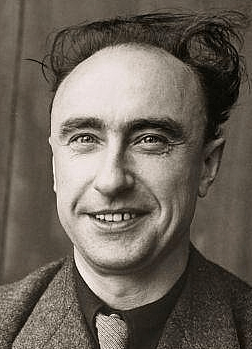Yves Tanguy facts for kids
Quick facts for kids
Yves Tanguy
|
|
|---|---|

Yves Tanguy in his Paris studio, photographed by Denise Bellon (1938)
|
|
| Born | January 5, 1900 Paris, France
|
| Died | January 15, 1955 (aged 55) Woodbury, Connecticut, U.S.
|
| Nationality | French and American |
| Known for | Painting |
| Movement | Surrealism |
| Patron(s) | Pierre Matisse |
Raymond Georges Yves Tanguy (born January 5, 1900 – died January 15, 1955), known as Yves Tanguy, was a French surrealist painter. He was famous for his unique and dream-like paintings.
Contents
About Yves Tanguy
Yves Tanguy was born in Paris, France, on January 5, 1900. His father was a retired navy captain. His parents were from a region in France called Brittany.
After his father passed away in 1908, his mother moved back to her hometown. Yves spent much of his childhood living with different family members.
In 1918, Tanguy worked briefly on a merchant ship. This is a ship that carries goods for trade. Later, he joined the Army. While in the Army, he became good friends with Jacques Prévert.
After his time in the military ended in 1922, he went back to Paris. He worked many different odd jobs. One day, he saw a painting by an artist named Giorgio de Chirico. He was so amazed by it that he decided to become a painter himself. He had never had any art lessons before.
Tanguy often became completely focused on the painting he was working on. He had a very small art studio. It only had enough space for one wet painting at a time. This might have been why he focused so much on each piece.
Becoming a Surrealist Artist
Around 1924, his friend Prévert introduced Tanguy to a group of surrealist artists. This group was led by André Breton. Surrealism was an art movement that explored dreams and the imagination.
Tanguy quickly started to create his own special painting style. He had his first art show in Paris in 1927. Later that year, he married his first wife, Jeannette Ducrocq.
During this busy time, André Breton offered Tanguy a contract. It said Tanguy would paint 12 artworks each year. With this steady income, he painted less than expected. He only created eight pieces for Breton.
In 1938, Tanguy traveled to London with his wife. He was there to show his first big art exhibition in Britain. It was at a gallery owned by Peggy Guggenheim. The show was very successful. Peggy Guggenheim wrote that Tanguy became rich for the first time in his life. She bought two of his paintings for her own collection.
Life in the United States
When World War II began, Tanguy was not able to join the military. He moved to New York with another artist named Kay Sage. He spent the rest of his life in the United States.
Sage and Tanguy got married in Nevada in 1940. Their marriage lasted a long time, but it was sometimes difficult. Near the end of the war, they moved to Woodbury, Connecticut. They turned an old farmhouse into an art studio. They lived there for the rest of their lives. In 1948, he became a citizen of the United States.
Yves Tanguy passed away in January 1955 in Woodbury. He had a stroke. His body was cremated. His ashes were kept until Kay Sage died in 1963. Later, his friend Pierre Matisse scattered his ashes. This happened on a beach in his beloved Brittany, along with his wife's ashes.
His Unique Art Style
Tanguy's paintings have a very special look. You can recognize them right away. They are a type of surrealism that doesn't show real objects. Instead, they show huge, dream-like landscapes.
These landscapes often use only a few colors. Sometimes, they have bright splashes of different colors. These strange places are filled with many abstract shapes. Some shapes are sharp like broken glass. Others look soft and organic, like giant amoebas that have turned to stone.
One of Tanguy's most famous paintings is Mama, Papa is Wounded! (1927). It shows falling shadows and a classical statue. It makes you feel like something bad is going to happen. The painting has an empty plain, a lonely plant, and small, helpless figures. Tanguy said he saw this image completely in his mind before he started painting it.
Tanguy's art style was very important. It influenced many younger painters. These artists include Roberto Matta and Wolfgang Paalen. His paintings also influenced the French animated movie Le Roi et l'oiseau (1980). They also inspired the science fiction book covers by illustrator Richard Powers.
Some of His Famous Paintings
- Vite! Vite! (1924)
- Rue de la Santé (1925)
- The Storm (1926)
- Mama, Papa is Wounded! (1927)
- Extinction of Useless Lights (1927)
- Old Horizon (1928)
- The Dark Garden (1928)
- Perfect Balance (1929)
- At 4 O'Clock in the Summer, Hope (1929)
- Similar Resplendence (1930)
- Promontory Palace (1931)
- The Certitude of the Never-Seen (1933)
- I Am Waiting for You (1934)
- The Passage of a Smile (1935)
- The Nest of the Amphioxus (1936)
- The Sun in its Jewel Case (1937)
- The Furniture of Time (1939)
- The Earth and the Air (1941)
- The Palace of the Windowed Rocks (1942)
- Indefinite Divisibility (1942)
- Through Birds, Through Fire and Not Through Glass (1943)
- The Rapidity of Sleep (1945)
- Fear (1949)
- Rose of the Four Winds (1950)
- The Invisibles / The Transparent Ones (1951)
- The Mirage of Time (1954)
- Multiplication of the Arcs (1954)
See also
 In Spanish: Yves Tanguy para niños
In Spanish: Yves Tanguy para niños

